Enhanced Spring Steel’s Strength Using Strain Assisted Tempering
Abstract
1. Introduction
2. Materials and Methods
2.1. Quenching and Tempering (QT) Process
2.2. Quenching and Strain Assisted Tempering Process
2.3. Methods
3. Results
3.1. Results of Mechanical Testing
3.2. Microstructural Analysis
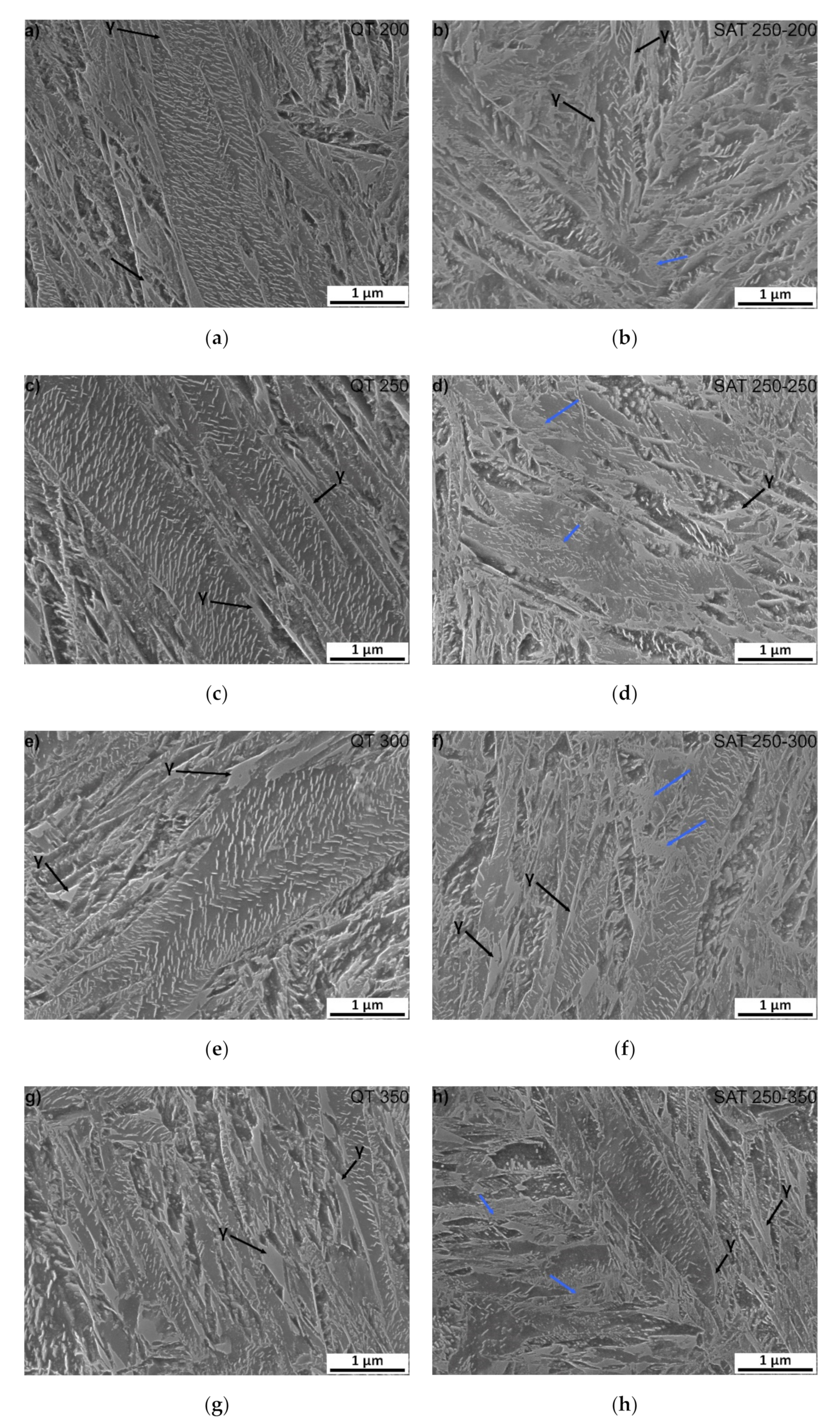
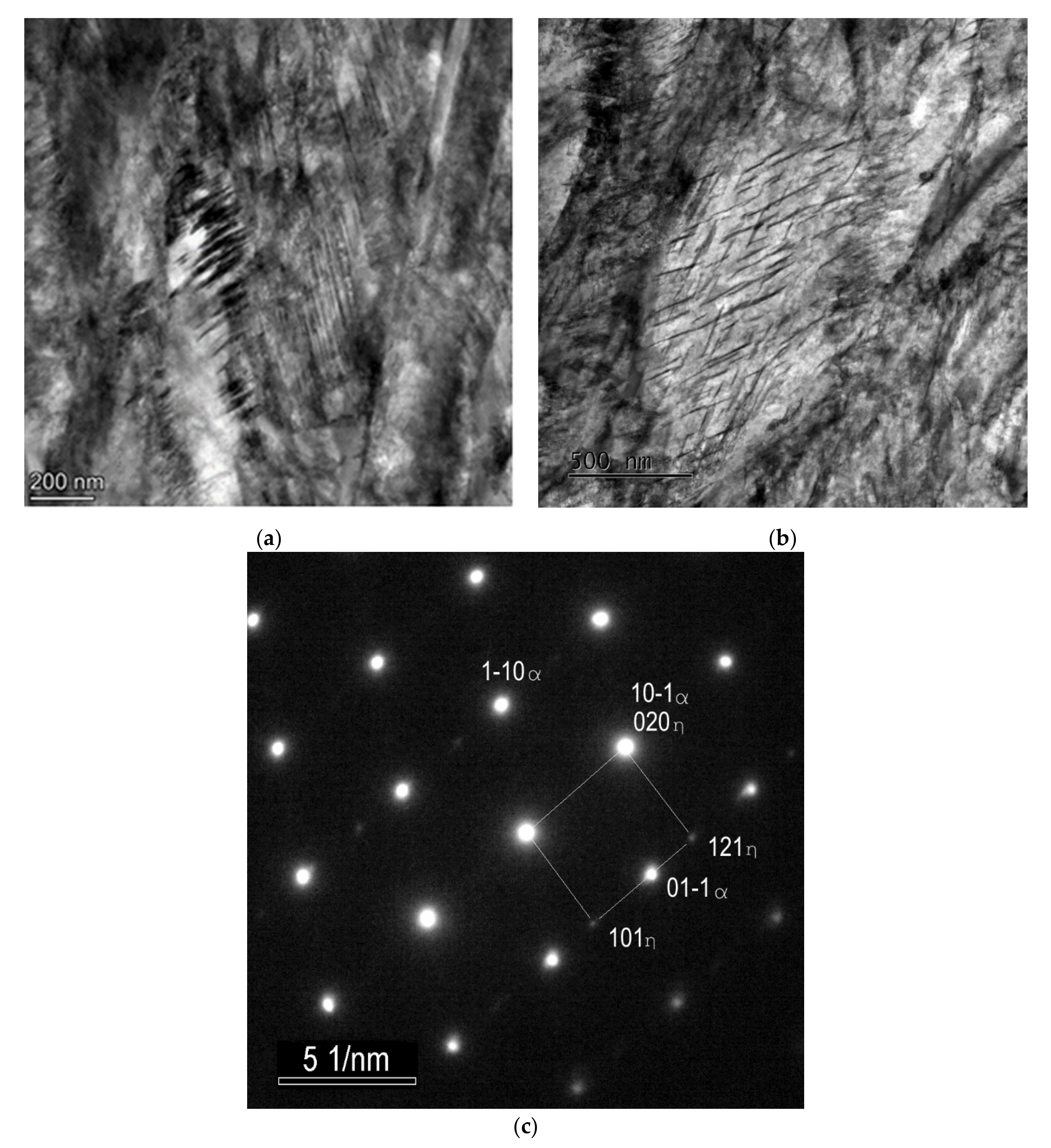

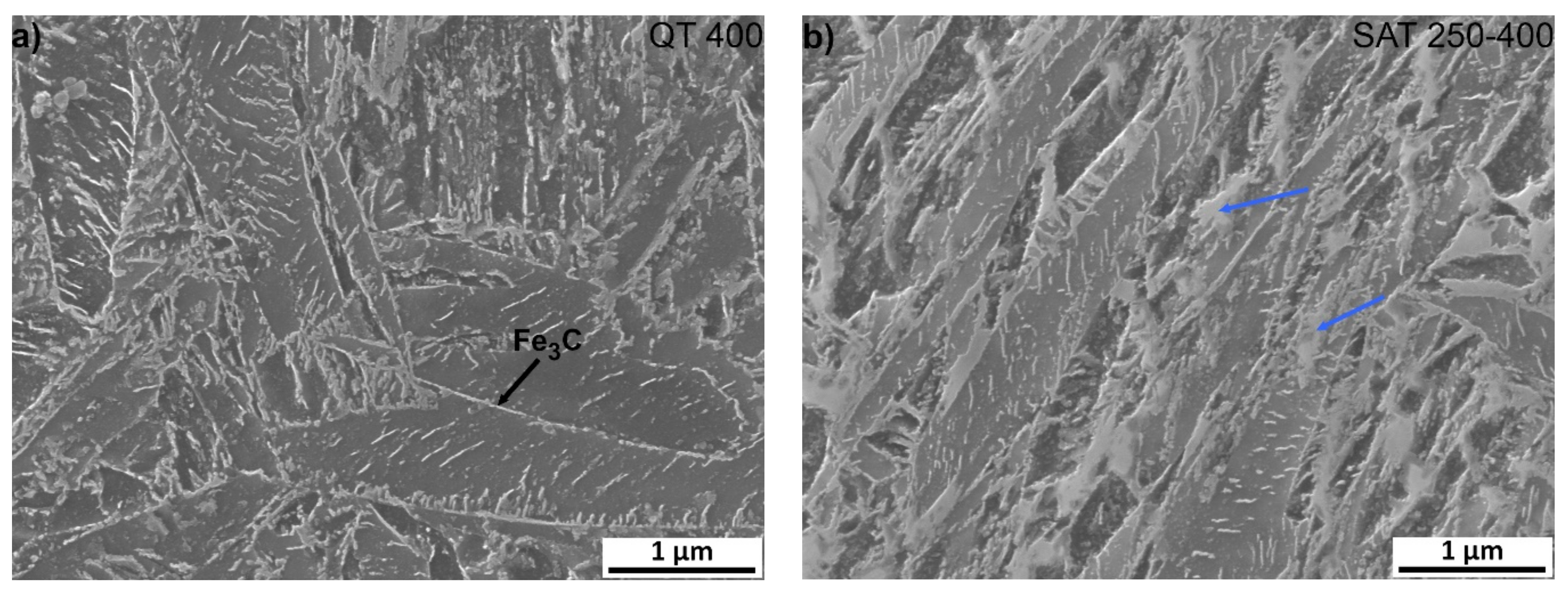
3.3. Dilatometry
- Just after quenching;
- After quenching and first tempering (at 200 °C or 250 °C);
- After quenching, first tempering (at 200 °C or 250 °C) and controlled strain of 17%.
3.4. Continuous Heating Tests
3.5. Isothermal Tests
4. Discussion
4.1. Development of Microstructure Features
4.2. Physical Mechanism for Changing Mechanical Properties
5. Conclusions
Author Contributions
Funding
Institutional Review Board Statement
Informed Consent Statement
Data Availability Statement
Conflicts of Interest
References
- Gao, Y.; Wang, Y. Hidden pathway during FCC to BCC/BCT transformations: Crystallographic origin of slip martensite in steels. Phys. Rev. Mater. 2018, 2, 093611. [Google Scholar] [CrossRef]
- Sun, C.; Fu, P.; Liu, H.; Liu, H.; Du, N.; Cao, Y. The effect of lath martensite microstructures on the strength of medium-carbon low-alloy steel. Crystals 2020, 10, 232. [Google Scholar] [CrossRef]
- Ganin, E.; Komem, Y.; Rosen, A. Shock induced hardness in α-iron. Mater. Sci. Eng. 1978, 33, 1–4. [Google Scholar] [CrossRef]
- Forsik, S.A.J.; Rivera-Diaz-Del-Castillo, P.E.J. Martensitic steels: Epsilon carbides in tempered. In Encyclopedia of Iron, Steel, and Their Alloys; CRC Press: Boca Raton, FL, USA, 2016; pp. 2169–2181. [Google Scholar] [CrossRef]
- Pierce, D.T.; Coughlin, D.R.; Williamson, D.L.; Clarke, K.D.; Clarke, A.J.; Speer, J.G.; De Moor, E. Characterization of transition carbides in quench and partitioned steel microstructures by Mössbauer spectroscopy and complementary techniques. Acta Mater. 2015, 90, 417–430. [Google Scholar] [CrossRef]
- Jung, J.-G.; Jung, M.; Kang, S.; Lee, Y.-K. Precipitation behaviors of carbides and Cu during continuous heating for tempering in Cu-bearing medium C martensitic steel. J. Mater. Sci. 2014, 49, 2204–2212. [Google Scholar] [CrossRef]
- Barani, A.A.; Li, F.; Romano, P.; Ponge, D.; Raabe, D. Design of high-strength steels by microalloying and thermomechanical treatment. Mater. Sci. Eng. A 2007, 463, 138–146. [Google Scholar] [CrossRef]
- Properties and Selection: Irons, Steels, and High-Performance Alloys; ASM International: Almere, The Netherlands, 1990; ISBN 978-1-62708-161-0.
- Radhakrishnan, V.M.; Baburamani, P.S. Initiation and propagation of fatigue crack in pre-strained material. Int. J. Fract. 1976, 12, 369–380. [Google Scholar] [CrossRef]
- Nagase, Y.; Suzuki, S. On the decrease of fatigue limit due to small prestrain. J. Eng. Mater. Technol. 1992, 114, 317–322. [Google Scholar] [CrossRef]
- Peng, Y.; Gong, J.; Jiang, Y.; Fu, M.; Rong, D. The effect of plastic pre-strain on low-temperature surface carburization of AISI 304 austenitic stainless steel. Surf. Coatings Technol. 2016, 304, 16–22. [Google Scholar] [CrossRef]
- Ghosh, S.K.; Haldar, A.; Chattopadhyay, P.P. Effect of pre-strain on the ageing behavior of directly quenched copper containing micro-alloyed steel. Mater. Charact. 2008, 59, 1227–1233. [Google Scholar] [CrossRef]
- Ungár, T.; Révész, Á.; Borbély, A. Dislocations and grain size in electrodeposited nanocrystalline Ni determined by the modified williamson–hall and warren–averbach procedures. J. Appl. Crystallogr. 1998, 31, 554–558. [Google Scholar] [CrossRef]
- Meyers, M.A.; Vöhringer, O.; Lubarda, V.A. The onset of twinning in metals: A constitutive description. Acta Mater. 2001, 49, 4025–4039. [Google Scholar] [CrossRef]
- Nnamchi, P.; Younes, A.; González, S. A review on shape memory metallic alloys and their critical stress for twinning. Intermetallics 2018, 105, 61–78. [Google Scholar] [CrossRef]
- Okazaki, K.; Conrad, H. Effects of interstitial content and grain size on the strength of titanium at low temperatures. Acta Met. 1973, 21, 1117–1129. [Google Scholar] [CrossRef]
- Ogawa, K.; Maddin, R. Transmission electron-microscopic studies of twinning in Mo-Re alloys. Acta Met. 1964, 12, 713–721. [Google Scholar] [CrossRef]
- Christian, J.W.; Mahajan, S. Deformation twinning. Prog. Mater. Sci. 1995, 39, 1–157. [Google Scholar] [CrossRef]
- Oriani, R. Ostwald ripening of precipitates in solid matrices. Acta Met. 1964, 12, 1399–1409. [Google Scholar] [CrossRef]
- Wang, Y.; Denis, S.; Appolaire, B.; Archambault, P. Modelling of precipitation of carbides during tempering of martensite. J. Phys. IV 2004, 120, 103–110. [Google Scholar] [CrossRef]
- Schmelzer, J.W.P.; Gokhman, A.R.; Fokin, V.M. Dynamics of first-order phase transitions in multicomponent systems: A new theoretical approach. J. Colloid Interface Sci. 2004, 272, 109–133. [Google Scholar] [CrossRef] [PubMed]
- Yen, H.-W.; Chen, P.-Y.; Huang, C.-Y.; Yang, J.-R. Interphase precipitation of nanometer-sized carbides in a titanium—Molybdenum-bearing low-carbon steel. Acta Mater. 2011, 59, 6264–6274. [Google Scholar] [CrossRef]
- Dicesare, E. Influence of Tempering, Prestraining, and Retempering on the Strength and Toughness of High Strength 4340 Steel; Army Materials And Mechanics Research Center Watertown: Watertown, MA, USA, 1967. [Google Scholar]
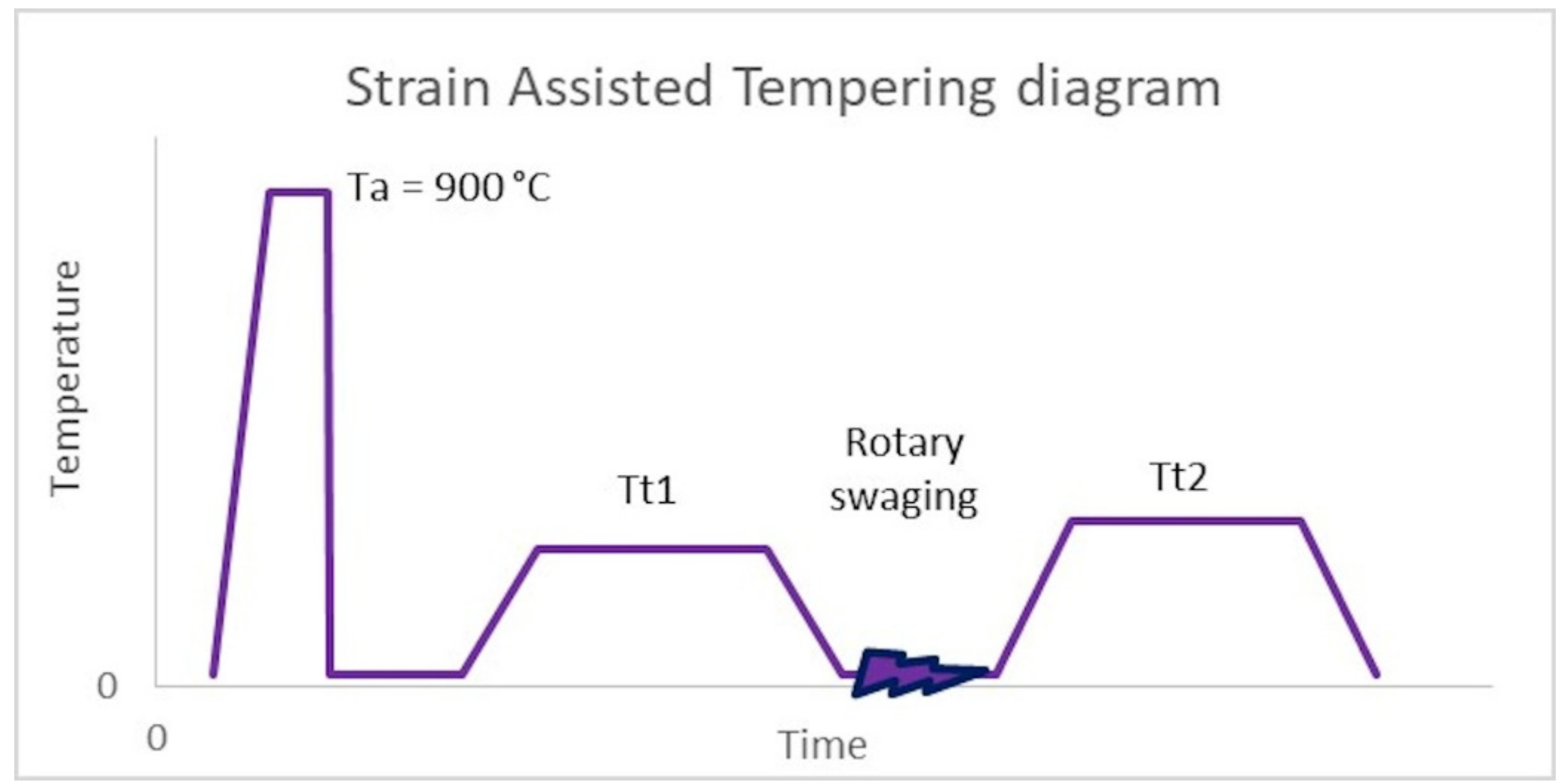

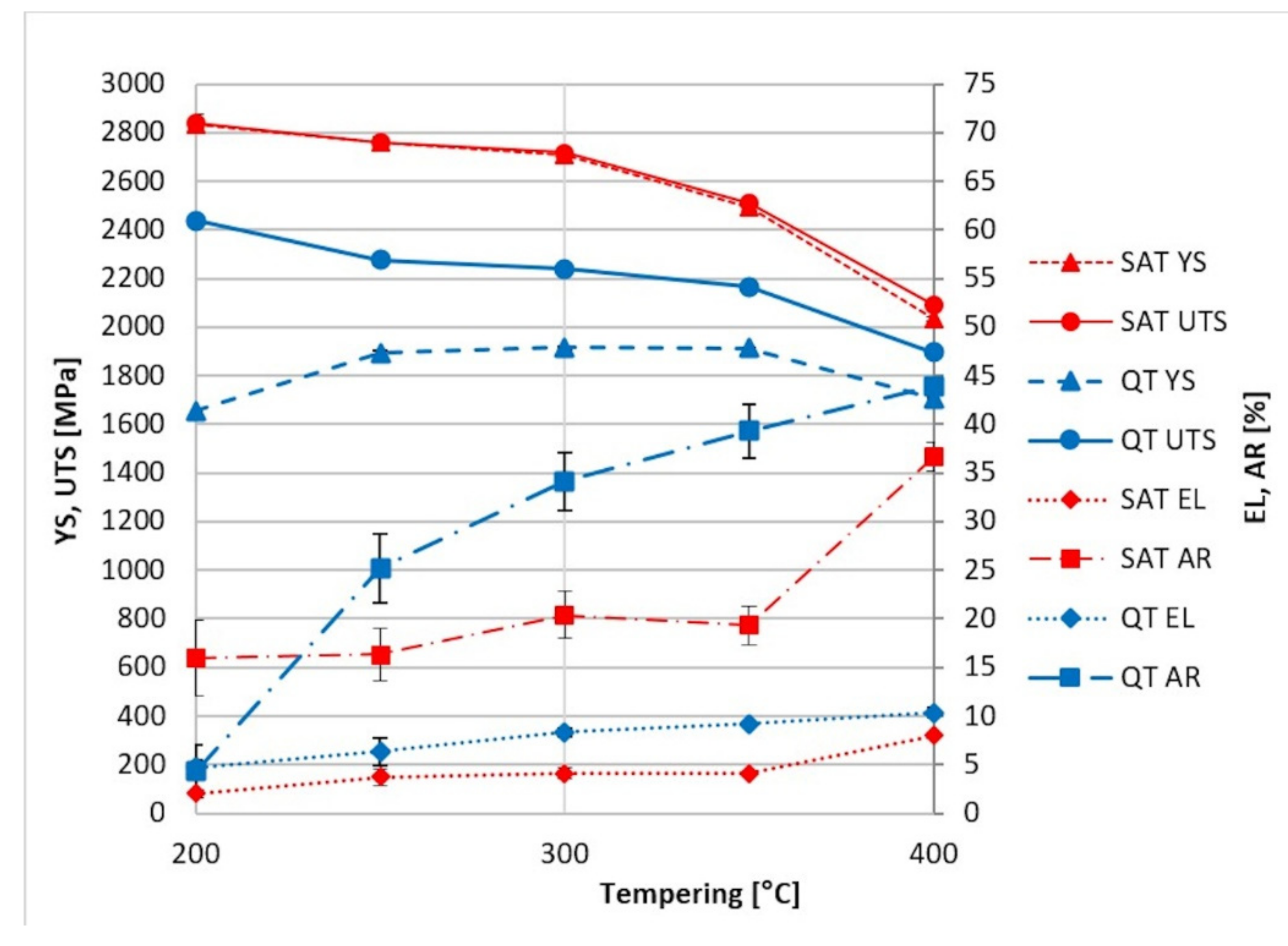
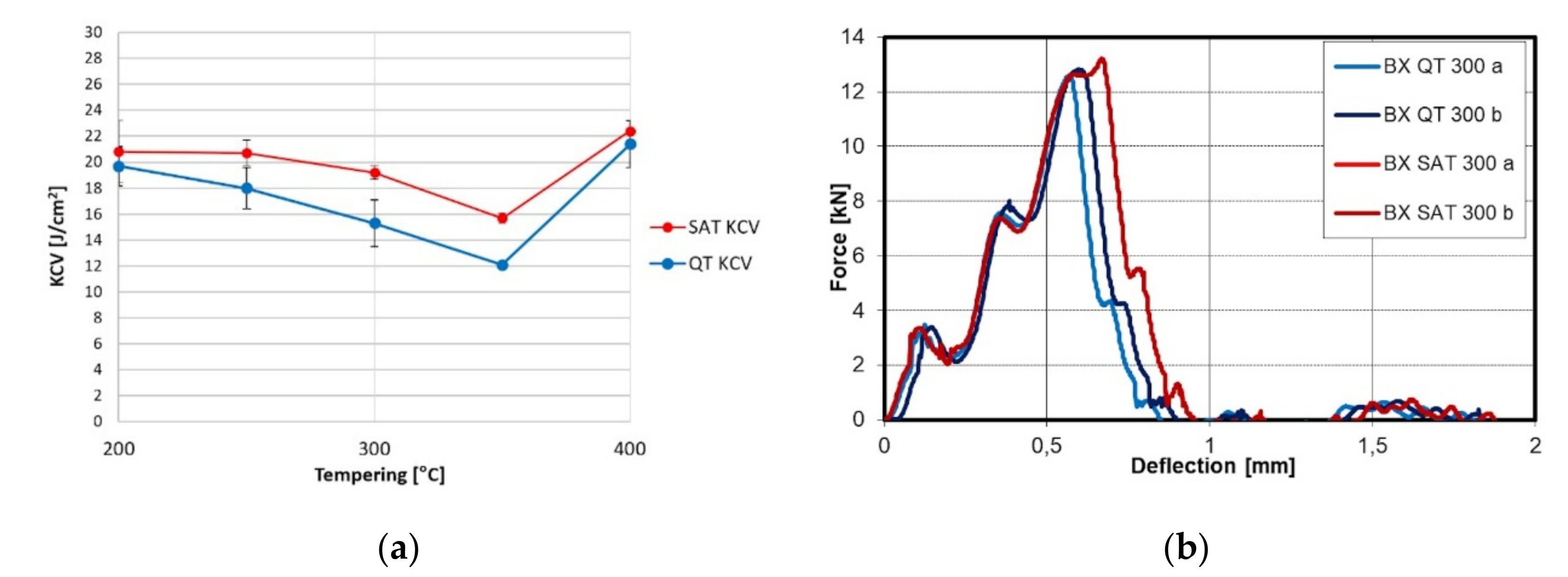
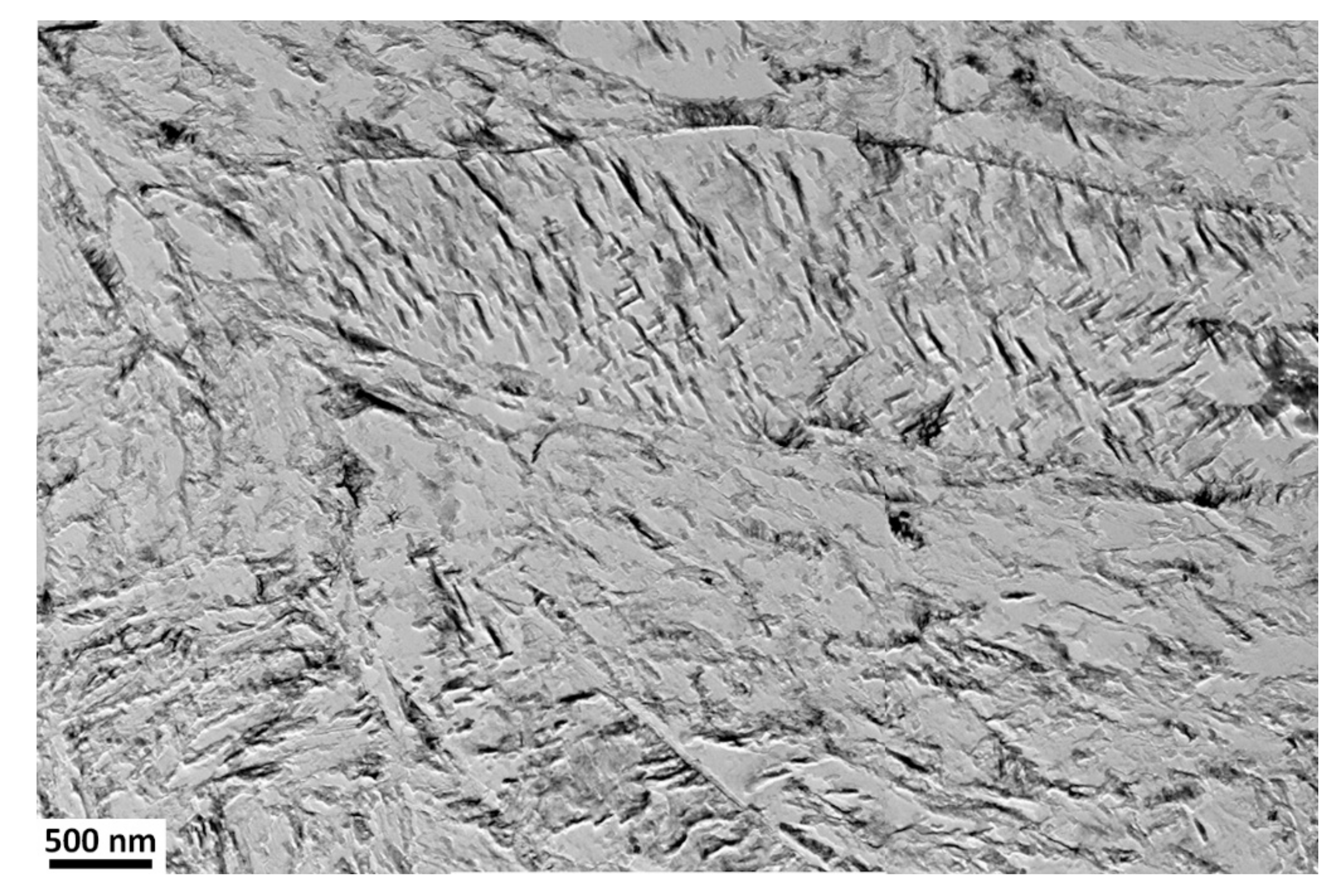
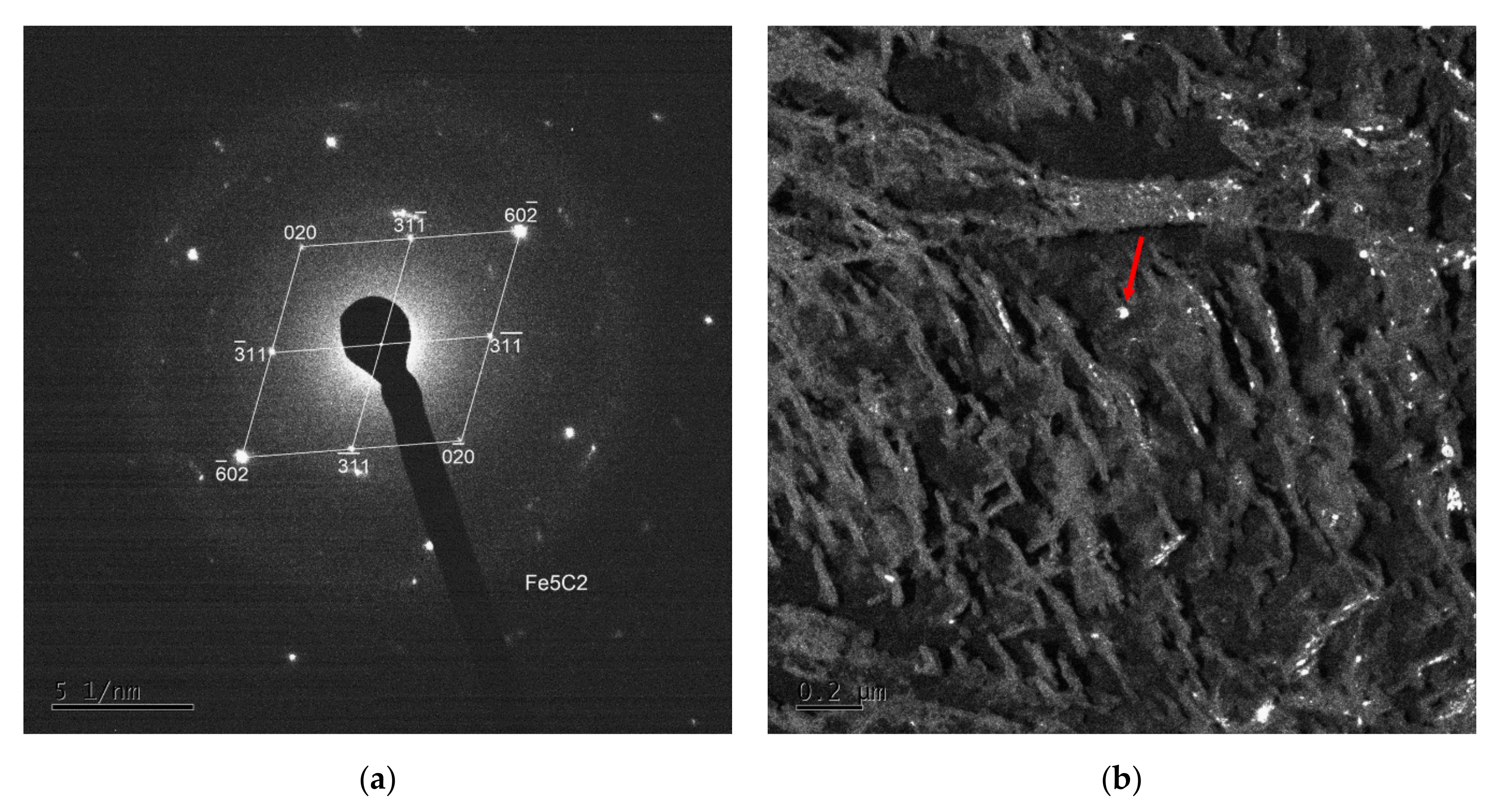

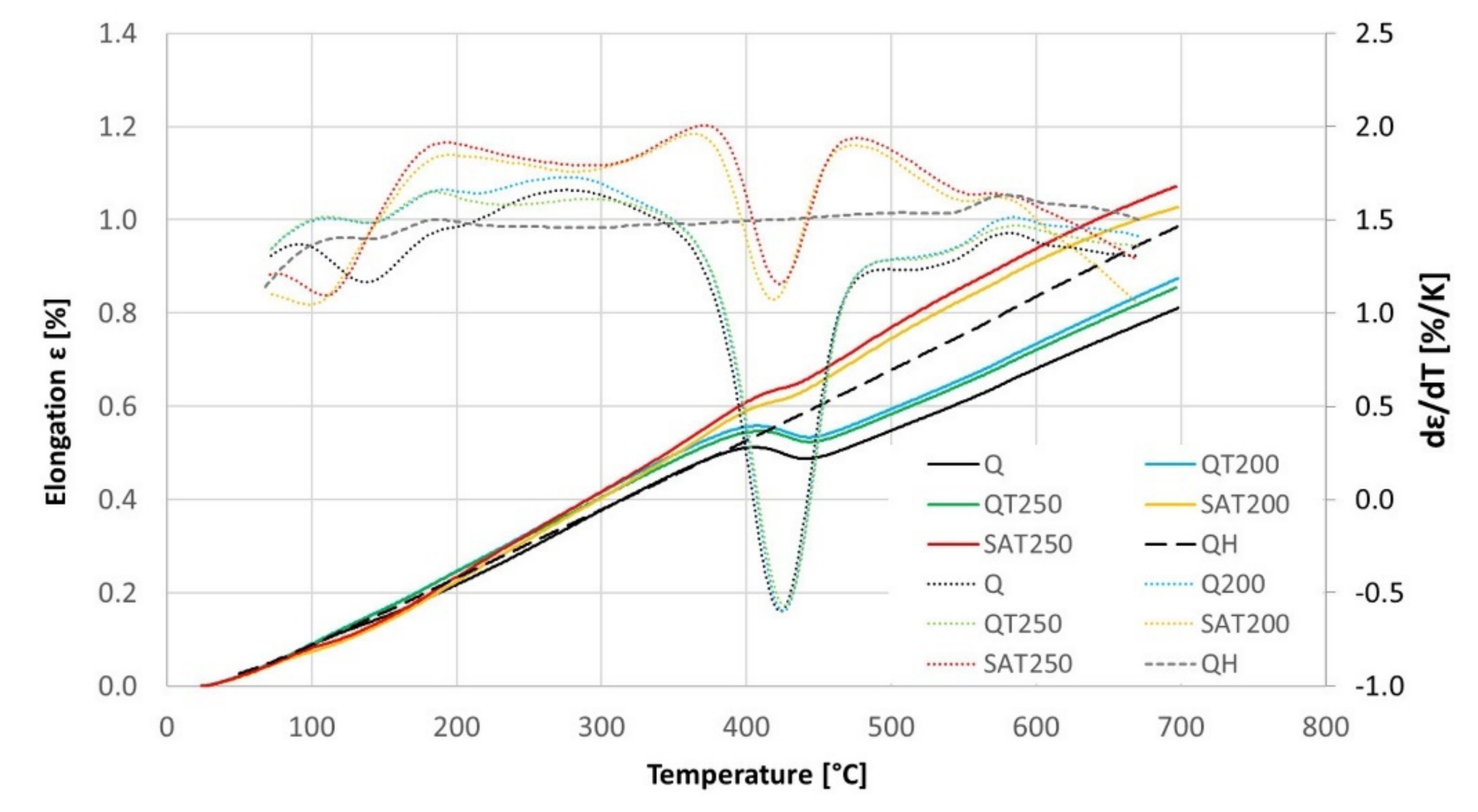
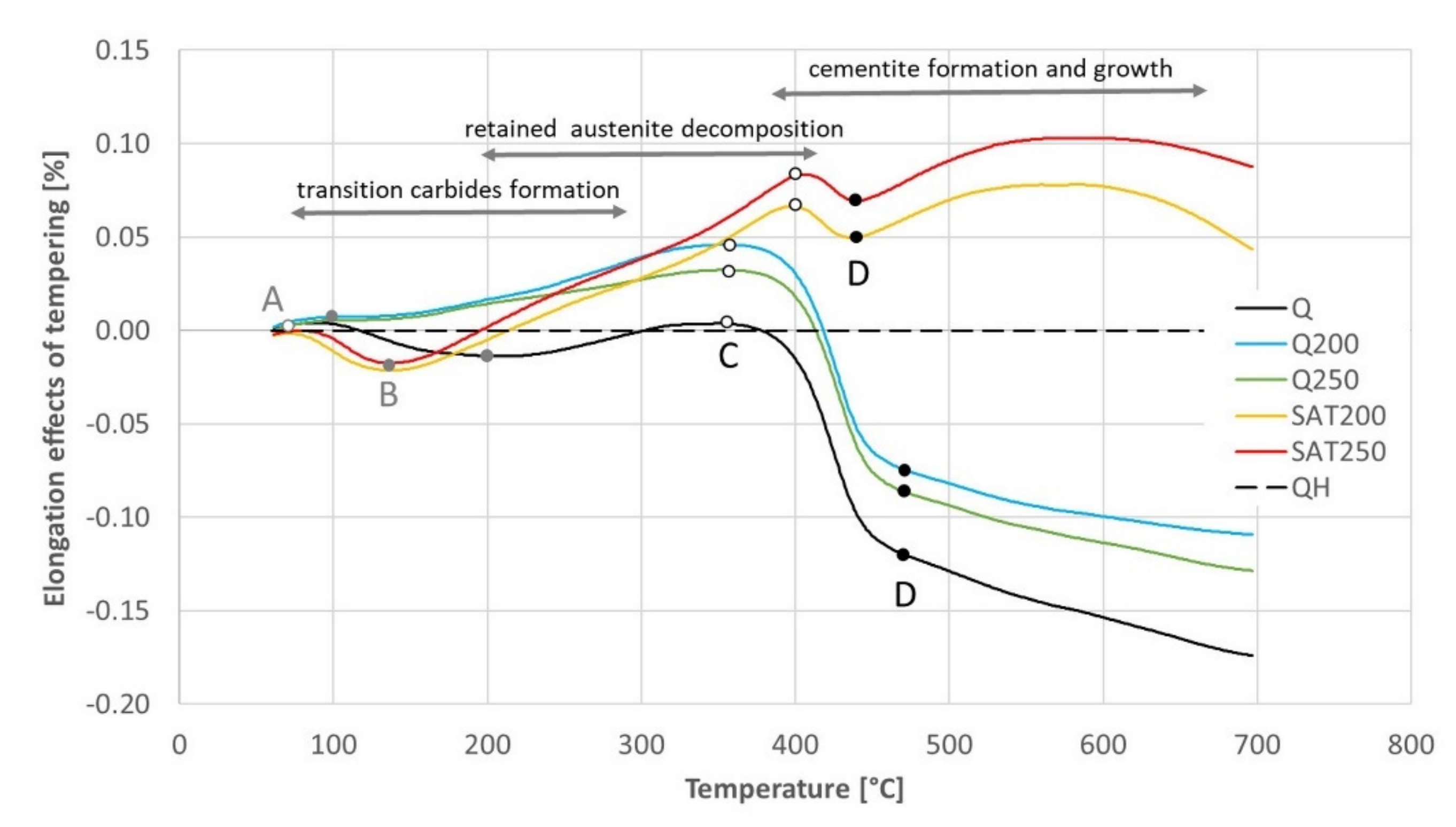
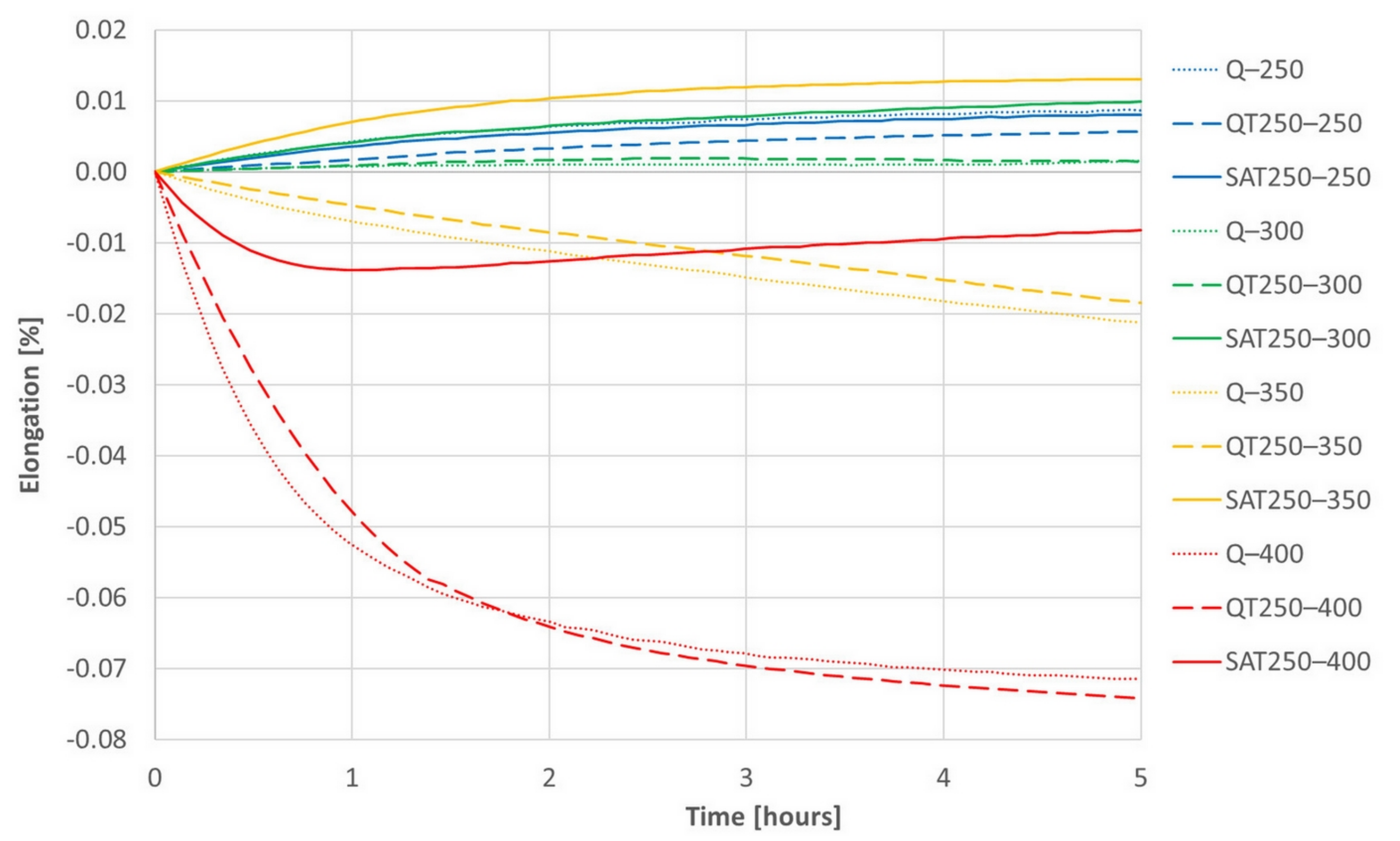
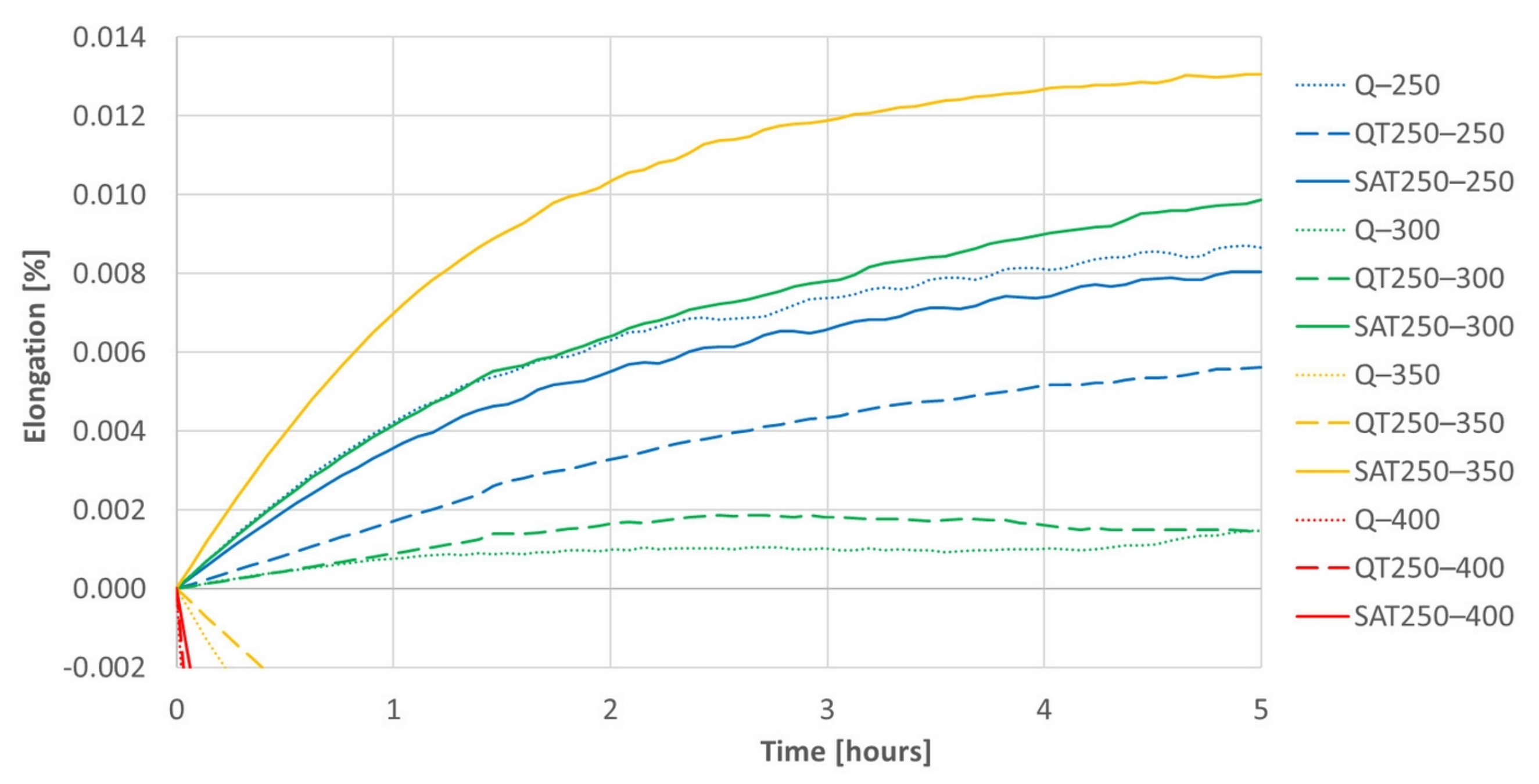
| Steel (wt%) | C | Si | Mn | Cr | Cu | Fe |
|---|---|---|---|---|---|---|
| BX | 0.57 | 1.5 | 0.68 | 0.75 | 0.12 | Bal. |
| 54SiCr6 | 0.51–0.59 | 1.2–1.6 | 0.5–0.8 | 0.5–0.8 | - | Bal. |
| Quenching Temperature (°C)/ Holding Time (h) | Tempering Temperature (°C)/ Time of Tempering (h) | Designation of the Sample |
|---|---|---|
| 900/20 | ----- | QT000 |
| 900/20 | 200/2 | QT200 |
| 900/20 | 250/2 | QT250 |
| 900/20 | 300/2 | QT300 |
| 900/20 | 350/2 | QT350 |
| 900/20 | 400/2 | QT400 |
| Quenching Temperature (°C)/ Holding Time (min) | 1st Tempering (°C)/(h) | Strain (%) | 2nd Tempering (°C)/(h) | Designation |
|---|---|---|---|---|
| 900/20 | 200/2 | 17 | --- | SAT 200 |
| 900/20 | 200/2 | 17 | 200/2 | SAT 200−200 |
| 900/20 | 250/2 | 17 | 200/2 | SAT 250−200 |
| 900/20 | 250/2 | 17 | 250/2 | SAT 250−250 |
| 900/20 | 250/2 | 17 | 300/2 | SAT 250−300 |
| 900/20 | 250/2 | 17 | 350/2 | SAT 250−350 |
| 900/20 | 250/2 | 17 | 400/2 | SAT 250−400 |
| 900/20 | 250/2 | 17 | 300/6 | SAT 250−300/6 |
| 900/20 | 250/2 | 17 | 300/10 | SAT 250−300/10 |
| Sample Designation | YS (MPa) | UTS (MPa) | EL (%) | AR (%) | KCV (J/cm2) |
|---|---|---|---|---|---|
| QT200 | 1654 ± 4 | 2439 ± 1 | 4.7 ± 0.7 | 4.3 ± 2.7 | 19.7 ± 1.5 |
| QT250 | 1893 ± 8 | 2277 ± 20 | 6.3 ± 1.4 | 25.2 ± 3.5 | 18.0 ± 1.6 |
| QT300 | 1915 ± 7 | 2241 ± 9 | 8.3 ± 0.4 | 34.1 ± 3.0 | 15.3 ± 1.8 |
| QT350 | 1912 ± 1 | 2167 ± 1 | 9.2 ± 0.1 | 39.3 ± 2.8 | 12.1 ± 0.1 |
| QT400 | 1705 ± 5 | 1897 ± 4 | 10.3 ± 0.5 | 43.9 ± 0.1 | 21.4 ± 1.8 |
| Sample Designation | YS (MPa) | UTS (MPa) | EL (%) | AR (%) | KCV (J/cm2) |
|---|---|---|---|---|---|
| SAT 200−200 | 2984 ± 4 | 2990 ± 3 | - | 7.7 ± 0.4 | 14.8 ± 3.5 |
| SAT 250−200 | 2836 ± 38 | 2837 ± 37 | 2.0 ± 0.4 | 15.9 ± 3.9 | 20.8 ± 2.4 |
| SAT 250−250 | 2753 ± 21 | 2759 ± 25 | 3.7 ± 0.8 | 16.3 ± 2.7 | 20.7 ± 1.0 |
| SAT 250−300 | 2709 ± 16 | 2717 ± 18 | 4.1 ± 0.6 | 20.4 ± 2.4 | 19.2 ± 0.5 |
| SAT 250−350 | 2491 ± 13 | 2511 ± 7 | 4.1 ± 0.1 | 19.3 ± 2.0 | 15.7 ± 0.4 |
| SAT 250−400 | 2036 ± 9 | 2091 ± 7 | 8.0 ± 0.1 | 36.7 ± 1.5 | 22.4 ± 0.2 |
| SAT 250−300/6 | 2601 ± 14 | 2612 ± 13 | 5.4 ± 0.9 | 20.8 ± 5.3 | 19.2 ± 1.5 |
| SAT 250−300/10 | 2619 ± 26 | 2630 ± 22 | 4.9 ± 1.0 | 30.8 ± 1.4 | 17.4 ± 1.7 |
| Initial State | Continuous Heating Tests | Isothermal Tests | ||||
|---|---|---|---|---|---|---|
| 200 °C | 250 °C | 300 °C | 350 °C | 400 °C | ||
| Sample Designation | ||||||
| as quenched | Q | Q200 | Q250 | Q300 | Q350 | Q400 |
| Tempered (200 °C/2 h) | QT 200 | QT 200–200 | QT 200–250 | QT 200–300 | QT 200–350 | QT 200–400 |
| Tempered (250 °C/2 h) | QT 250 | QT 250–200 | QT 250–250 | QT 250–300 | QT 250–350 | QT 250–400 |
| tempered (200 °C/2 h) +17% strain | SAT 200 | SAT 200–200 | SAT 200–250 | SAT 200–300 | SAT 200–350 | SAT 200–400 |
| tempered (250 °C/2 h) +17% strain | SAT 250 | SAT 250–200 | SAT 250–250 | SAT 250–300 | SAT 250–350 | SAT 250–400 |
| Preparation | Assumed Dominant Dilatometric Effect | ||||||||
|---|---|---|---|---|---|---|---|---|---|
| Transition Carbides | Austenite | Cementite | |||||||
| A | B | C | D | ||||||
| Q | quenching | 80 °C 0.004% | −0.018% | 200 °C −0.014% | +0.018% | 360 °C 0.004% | −0.124% | 470 °C −0.120% | |
| QT200 | temp. 200 °C | – | – | 100 °C 0.005% | +0.043% | 360 °C 0.048% | −0.122% | 470 °C −0.074% | |
| QT250 | temp. 250 °C | – | – | 100 °C 0.005% | +0.027% | 360 °C 0.032% | −0.118% | 470 °C −0.086% | |
| SAT200 | SAT 200 °C | 80 °C 0.000% | −0.021% | 140 °C −0.021% | +0.087% | 400 °C 0.066% | −0.016% | 440 °C 0.050% | |
| SAT250 | SAT 250 °C | 80 °C 0.000% | −0.017% | 140 °C −0.017% | +0.100% | 400 °C 0.083% | −0.014% | 440 °C 0.069% | |
Publisher’s Note: MDPI stays neutral with regard to jurisdictional claims in published maps and institutional affiliations. |
© 2022 by the authors. Licensee MDPI, Basel, Switzerland. This article is an open access article distributed under the terms and conditions of the Creative Commons Attribution (CC BY) license (https://creativecommons.org/licenses/by/4.0/).
Share and Cite
Nový, Z.; Salvetr, P.; Kotous, J.; Motyčka, P.; Gokhman, A.; Donik, Č.; Džugan, J. Enhanced Spring Steel’s Strength Using Strain Assisted Tempering. Materials 2022, 15, 7354. https://doi.org/10.3390/ma15207354
Nový Z, Salvetr P, Kotous J, Motyčka P, Gokhman A, Donik Č, Džugan J. Enhanced Spring Steel’s Strength Using Strain Assisted Tempering. Materials. 2022; 15(20):7354. https://doi.org/10.3390/ma15207354
Chicago/Turabian StyleNový, Zbyšek, Pavel Salvetr, Jakub Kotous, Petr Motyčka, Aleksandr Gokhman, Črtomir Donik, and Ján Džugan. 2022. "Enhanced Spring Steel’s Strength Using Strain Assisted Tempering" Materials 15, no. 20: 7354. https://doi.org/10.3390/ma15207354
APA StyleNový, Z., Salvetr, P., Kotous, J., Motyčka, P., Gokhman, A., Donik, Č., & Džugan, J. (2022). Enhanced Spring Steel’s Strength Using Strain Assisted Tempering. Materials, 15(20), 7354. https://doi.org/10.3390/ma15207354







